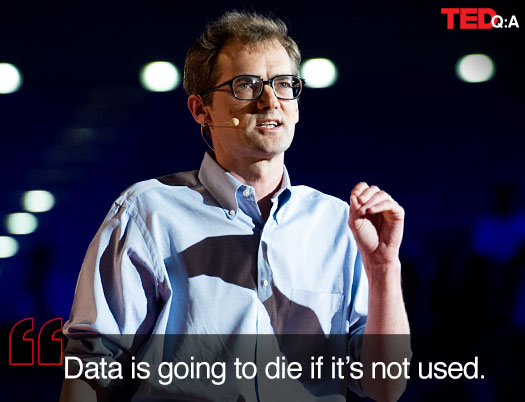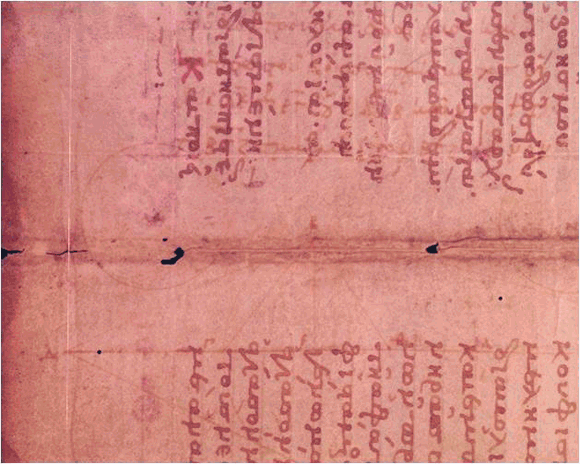
At TEDxSummit, Walters Art Museum curator William Noel gave this fascinating talk on revealing the lost codex of Archimedes. The TED Blog caught up with him to talk about the digital future of a traditionally closed institution: the art museum.
As with the Archimedes codex, the Walters Art Museum’s online collection operates under the Creative Commons license. I can’t imagine that many museums join the Walters in this respect; why did the museum decide to opt for that license as opposed to something more restrictive?
The decision was actually driven by our experiences with the Archimedes manuscript and making all that data available under a Creative Commons license. When we started imaging our manuscripts at the Walters, we did the same. We just think that Creative Commons data is real data. It’s data that people can really use. It’s all about access, and access is about several things: licensing and publishing the raw data. Any data that you capture should be available to be the public. For our manuscripts, that’s what we’ve done.
The other important thing is to put the data in places where people can find it — making the data, as it were, promiscuous. That means putting it on Flickr, Pinterest, that sort of thing; these are forums people are used to using and commenting on, which they already use to build datasets of their own.
The Walters is a museum that’s free to the public, and to be public these days is to be on the Internet. Therefore to be a public museum your digital data should be free. And the great thing about digital data, particularly of historic collections, is that they’re the greatest advert that these collections have. So: Why on Earth would you limit how people can use them? The digital data is not a threat to the real data, it’s just an advertisement that only increases the aura of the original, so there just doesn’t seem to be any point in putting restrictions on the data. There is the further fact that the data is funded by taxpayers’ money. So it didn’t seem fair to limit what taxpayers could do with the data that they paid for.
I’m not in a position to speak for other institutions, but sometimes you can’t digitize your collections because you don’t have the money, and that’s fair enough. But what I would say is that getting the public, both scholars and the general public, to pay for digital images … this is sort of an open secret, but in the vast majority of cases, this is not a business model that works. There really wasn’t a reason not to do a Creative Commons license, and it was foundational to what we wanted to do. One of the issues is that a lot of people who are in a position to make decisions vis-à-vis a special collection don’t really understand the difference between a digital object and the real object. That’s a structural problem that will change; I really passionately believe this.
One last thing: Data is going to die if it’s not used, so you want your data to be as easily usable as possible, and a Creative Commons license is an integral part of that.
You ask in your talk “what’s in it for the institution?” Being a publicly funded institution means something a lot different than being privately funded. Can you expand on what you think is “in it” for the institution to use Creative Commons licensing?
Institutions with special collections, particularly museums — libraries perhaps less so — want to improve their brand and raise visitorship. One way in which they can do that is through advertising. And what better way to advertise than by making instantly available, or as available as possible, images of their collections? Because that’s how they get known. What I say in a very abbreviated form in my talk is that people go to the Louvre because they’ve seen the Mona Lisa; the reason people might not be going to an institution is because they don’t know what’s in your institution. Digitization is a way to address that issue, in a way that with medieval manuscripts, it simply wasn’t possible before. People go to museums because they go and see what they already know, so you’ve got to make your collections known. Frankly, you can write about it, but the best thing you can do is to put out free images of it. This is not something you do out of generosity, this is something you do because it makes branding sense, and it even makes business sense. So that’s what’s in it for the institution.
The other main reason to do it is to increase the knowledge of and research on your collection by the people, which has to be part of your mission at least, even in the most conservative of institutions. People can find out more about your materials, work on them, and add knowledge to your collections. And that’s good for everybody, not just institutions. That’s what history is, and that’s what makes history alive.

These days we’re not trying to preserve Archimedes’ intellectual property. When do you think a piece of art or text becomes the property of the public, as opposed to belonging to the author or the artist?
There are plenty of legal precedents for establishing the estate of authors and painters and that sort of thing. One of the great luxuries of being a fan of the Middle Ages, like me, is that I don’t have to worry about it. I only have to make sure that the digital images that I capture of these things are available under free licensing and there’s no restrictive copyright on the images. I’m just very glad I’m not advocating for this in the 20th century. Institutions that have modern collections are in a fundamentally different position.
The right of the artist is one reason people might resist the “freeing” of data.
My answer to that is sure, but of course it shouldn’t be applied to the Middle Ages! Actually libraries containing special collections of medieval materials are normally very careful to write restrictive copyright on their materials. Part of this is historical; that is to say, when images of these manuscripts were published in books, it didn’t have to behave like digital data, and it didn’t have to be free for people to use in all sorts of ways and in different contexts. The images were just reproduced in other books. But those days are fast running out, and digital images need to be free, so that people can do what they need to do with them and what they want to do with them. That’s the great thing about digital data!
So part of that is historical: You used to restrict the use of your books to try and make money off reproductions in other books. It was expensive, but it wasn’t crippling. Today these copyright restrictions are now crippling scholarship and access by the general public. The other thing is that a lot of these collections are in national institutions, university libraries, and they are the prized cultural heritage of these institutions. The policymakers in those institutions don’t like the idea that reproductions of these images can be available for free. It feels to them like you are denigrating your greatest asset. That’s a state of mind that belongs to my grandfather — for whom I have great affection, but to whom I don’t listen much anymore.
When you can access something for free, a piece of music or a piece of text, what is the incentive to pay for it, to get in your car to go see something?
Because you want something that is not a collection of ones and naughts made sense out of a style sheet. You want to go to something that is made literally of flesh, rather than organized energy that is going to disappear at the press of a keystroke. There is nothing like touching history, smelling history, reading it from a 700-year-old book. There are lots of things that digital data can do, things that medieval manuscripts cannot do — aggregating, virtually putting together a medieval library of things which are not disparate, searching it once it’s been transcribed — but there’s a lot digitizing an object can’t do. And for that, people are going to have to go and consult or see the original. (But the way the public is going to see that the original is there is by first seeing a digital avatar on the web. That’s the point.)
Do you think there’s a place in the future for that mentality which wants to preserve cultural heritage by keeping it behind closed doors?
It’s not over. Much more survives from the Middle Ages than people think, and the job of digitizing our medieval heritage is truly enormous, so it’s going to take time. At the end of the day there might be some holdouts, but they’re going to be utterly marginalized and, frankly, derided. And they won’t be allowing their great cultural treasures to contribute to the course of historical study.
Where is the Archimedes palimpsest now?
The vast majority of it has been returned to its owner, who is anonymous. An exhibition opens in Hildesheim, Germany on Sunday, June 3, and several leaves of the palimpsest will be there. In early 2014 there’s going to be a exhibition including 20 leaves at the Huntington Library in Los Angeles.
What’s the next step for you?
We’re still digitizing our medieval manuscripts. We just got a new grant to digitize 100 manuscripts of Flemish treasures. One of the things that we’re going to do is try and make our data as promiscuous as possible, to advocate for it, to integrate it with other initiatives that are being built on the user end. And my personal goal for the future is to make as much medieval data as possible available in its raw form to be used for any non-commercial purpose.
Comments (18)
Pingback: Making Data Promiscuous | Alena M. Buis
Pingback: Well, gosh. - Open Objects
Pingback: Permissions and the Postgraduate: What you need to know about the right to reproduce |
Pingback: “Can I use this?” and Other Questions about Digital Image Access | Illinois Pixels
Pingback: Finding Archimedes in a Prayer Book | Weekends in Paradelle
Pingback: Why your institution should free up its images and metadata | L.A.M. Chops
Pingback: “Can I Use This?” How Museum and Library Image Policies Undermine Education |e-Literate
Pingback: The Archimedes Palimpsest « David Bjoerling Jensen
Pingback: Wide-Open Apocalypse. « The Sonny Wilkins Chronicle
Pingback: Issue 2 (5 June 2012) | The Digital Museum
Pingback: Art in the Digital World: Property of the public? |
Pingback: Four short links: 30 May 2012 | Share Blog